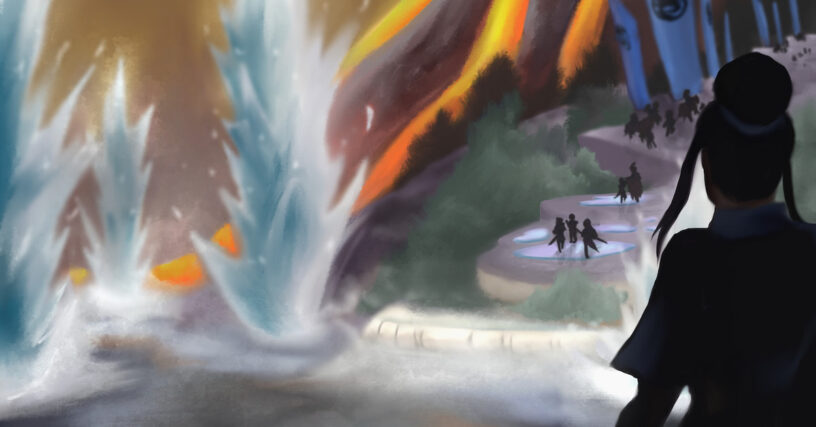We continue revealing the cards from Ancient Secrets. This time we move north in Sanctuary, as we approach the Crab and the Crane. Both clans used to be deeply defined by their environment in Rokugan: what is a Crab without evil to fight, and what is a Crane without a court in which to shine?
Sealing a Trait
Before we dive into the previewed cards, we want to talk briefly about Traits. A common theme of Ancient Secrets is increasing the importance of Traits, with many cards referencing specific Traits — some more common, others less. By making Traits a larger concern in the game we make deck-building more complex, resulting in a metagame richer in variety. To make this focus on Traits matter we must address a few cards released in the past that make Traits too easily accessible. Those cards are the collection of Seal of the Clan (with versions for all 7 clans) and A New Name; the Seals were important in the early life of the game as an enabler for secondary Traits, but with the current card pool they’re not as needed anymore, and usually only see play in degenerate strategies. The same issue arises with A New Name, making too accessible some of the most important Traits in the game. With the release of Ancient Secrets all seven Seals of the Clan and A New Name will be banned. It is not a decision we take lightly, but it will allow us to advance the game quicker. We choose to mention it here, as we have cards in the following clans that could be strongly impacted by the availability of the Seals or A New Name. Now let’s check the cards.
The Crab Rumbles
The overall design of the Crab Clan oscillates between two frequencies: the steady and grindy rhythm of defensive strategies, or the intense explosiveness of berserkers and swarm tactics. In Ancient Secrets we stick to that rubric and bring more tools to each of those play styles. We also bring into focus the Kuni family as obstinate hunters of evil, instead of the customary shady dealings of Kuni Yori. And just as the Crab left their holdings across the sea, so do we, with the first set ever in which there is not a single Crab holding.
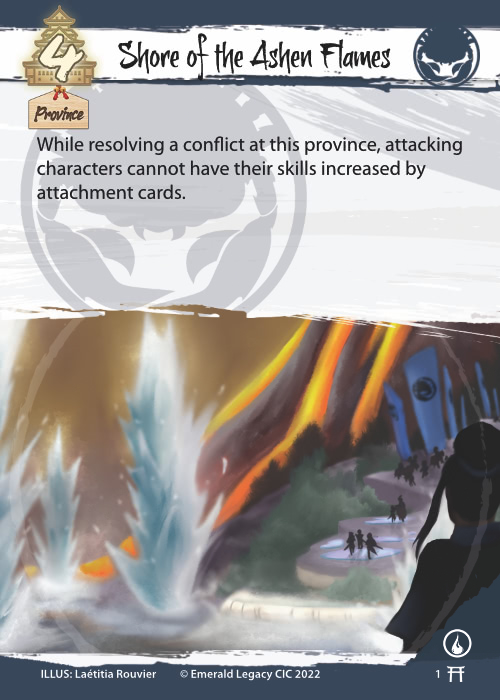
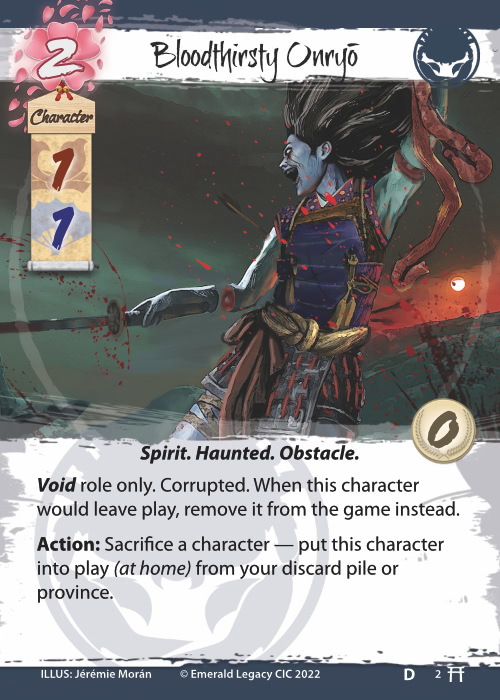
The Crab Clan chose the Shore of Ashen Flames as their landing site. The area is hot and smoky, heavy with vapors from hot springs and geysers. The region also hosts a few fertile areas enriched by the water that comes from the slopes of the volcano, but the shores themselves are as rough as hardened Kaiu armor. As if that wasn’t enough, the spiritual barriers between Ningen-do and Toshigoku are weakened in that area, allowing possessed spirits to cross into the mortal realms.
The Shore of Ashen Flames makes for a powerful defensive province in some matchups. Armies who decide to engage with the Crab by the shore will find their equipment of little value as the sand and salt-water negates any advantage their trappings could provide; likewise for courtiers when they find their beautiful kimono ruined by smoke and humidity. The advantage gained by Shore should help the Crab to outlast their opponents as they can defend with higher efficiency. But even with those advantages in their favor, the Crab must still be able to handle the opponent’s abilities that depend on skill, such as duels and other similar effects, as the Shore of Ashen Flames only affects the opponents during resolution.
The Bloodthirsty Onryō can rise from the dead by possessing the body of another character in play. The original character gets sacrificed and is replaced by the Onryō. As a Corrupted character, it comes into play with a Tainted status that confers it +2 military and +2 political skill. But that dark power has a price, as the Onryō’s controller must lose 1 honor each time they commit it into a conflict due to the Tainted status. Whenever the Taint helps you, remember, ultimately it might destroy you.


The Kuni family excels in detecting and fighting corruption, but that is not how they have been represented in the LCG. Throughout the game’s life, most of the Kuni cards skewed more towards using corruption to your benefit instead of going against it. In Ancient Secrets we aim to change that, as we bring forward a new Crab strategy where they can actually oppose the darkness instead of joining it.
Kuni Juurou is a Witch Hunter who takes his job seriously. His Action allows the Crab player to find which enemy characters are secretly corrupted and expose their corruption. Once exposed, Juurou helps fight them by giving all such characters a penalty that cancels out the benefit from being tainted — evil cannot be a source of strength! This penalty also affects Haunted beings as would be the case of someone haunted by their Jealous Ancestor. Last, Juurou will not resort to dishonorable tactics in his hunt and neither will he allow other allies to do the same. The restriction on paying honor costs means effects like Assassination or Fire and Oil cannot be used by the Crab player while Juurou is in play, and it also makes it impossible for them to declare tainted characters to conflicts. This removes many common tools from the Crab toolbox, offsetting the powerful abilities of Kuni Juurou. One of the few dishonorable tools that remains is Kuni Laboratory, as the honor loss in that case is an effect and not a cost — the Kuni know there’s no dishonor in research, regardless of what others might say.
To further support Shugenja strategies out of the Crab, we have the Earnest Sculptor. It can offset the cost of Jade cards like Finger of Jade and Jade Tetsubo providing protection and means of fighting the darkness. It can also find Spells to nullify the opposition like Jade Strike or other circumstantial options like Cloud the Mind and The Maiden’s Icy Grasp. The support nature of the Sculptor is reinforced by their low stats, but useful array of Traits and high glory.
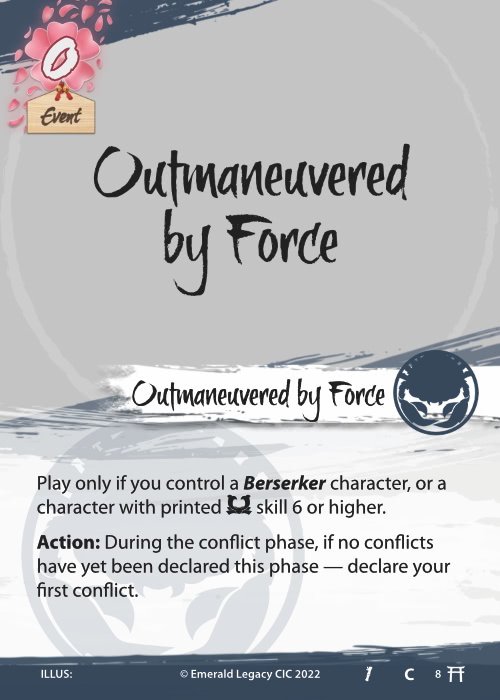
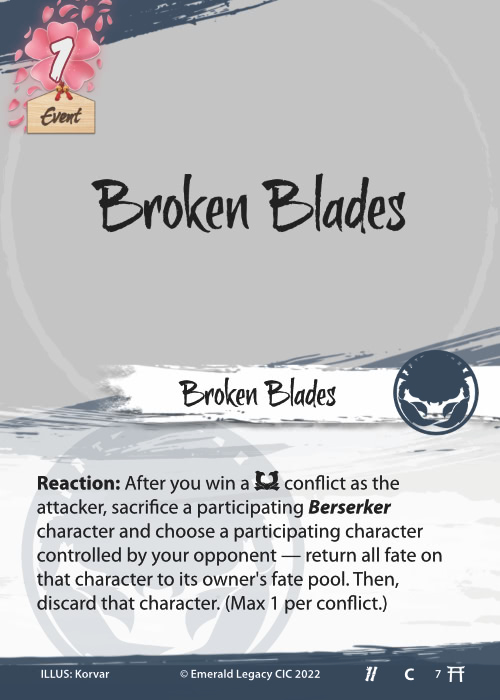
When the energy contained in the Crab erupts, the fury of the berserkers shakes the ground. For some time berserker decks have been almost there, close to realizing their potential but always missing a few key parts to work. One glaring weakness is the strong dependance of Castle of the Forgotten on being the first player in the round to be able to accomplish anything. Another weak spot is a lack of interaction with the opponent that often leaves that strategy suddenly incapable of crossing the finish line.
Outmaneuvered by Force supports the rhythm issues of berserkers. Once the Crab have the strength or the fury, they can stop with the niceties and jump into action. By taking the initiative, the Crab can try to dominate with their forces before the opponent gets a chance to cause any damage. This rush forward does not change who is the first player, which allows the Crab player to get first conflict on the round they play Outmaneuvered, and also on the following round.
The might of the Hida is not only swift, but also lethal. Broken Blades raises the stakes of defending against a berserker, making it particularly dangerous to confront them. Their enemies must step into the battlefield ready to win or die trying, for the berserkers offer no mercy. This additional risk in defending makes it trickier to drain resources from the Crab with minor defenses, helping berserkers keep momentum. Note that since most berserkers cost a fair amount of fate themselves, sacrificing them is usually more expensive than other Crab sacrifices.

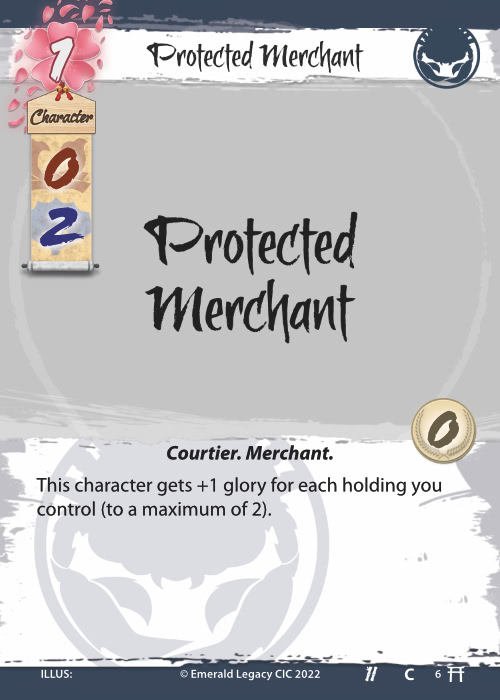
The new Crab lands are also the home of other less dramatic people and creatures. Lounging amid the warmth of the volcano we can find the Cinder Salamander. Taking refuge among the fresh constructions we also find Protected Merchants, just getting started, setting out their stalls and workshops.
The Cinder Salamander is a great source of cheap characters. They’re attracted by fire, and once the Crab claims that element a single Salamander can quickly multiply. They can find use on the offensive supported by Kuni Laboratories, defensively under the protection of Shiro Nishiyama, or as sacrifice sources for multiple Crab abilities. And they keep on coming every round, as long as you can tame the fire.
The Protected Merchant is a simple conflict character, who starts at a humble 0 glory, but can quickly reach 2 glory. That makes them a dependable threat on political conflicts, and a useful tool to fight for control of the Imperial Favor. They are also the first Merchant character who can reach 2 glory on their own, making them a great enabler of To Connect the People.
The Crane Whispers
The followers of Lady Doji find themselves in an environment that is as full of potential as it is full of danger. Far from the trappings of civilization, they must build a new home fit for themselves, and also fit for guests. The Crane are defined by an existence in service to others. A service that is rendered by keeping warm the hearth of culture. In Ancient Secrets we approach the Crane in their quest for excellence, and also in the struggle for survival. We explore those themes in cards supporting both Crane honor strategies and their Daidōji defenders in Mioko’s Song.

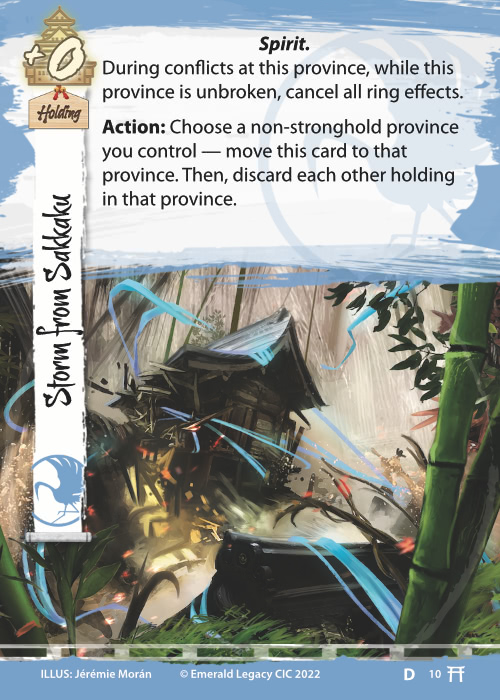
The Crane clan set their base in the Forest of Rustling Whispers. The forest is a majestic area covered in bamboo — the sounds of rivers and the shade from the canopy create an atmosphere of serenity. At first look that calm is pervading, but as twilight approaches the spirits of the forest come to fore. And they are not happy with their new neighbors.
The Forest of Rustling Whispers is a versatile province. The beauty of the region offers an opportunity for Crane to turn its qualities into honorable deeds. Its defensive nature makes it valuable for strategies focused on winning by honor, as a reusable source of honor tokens. Granted it competes with Tsuma, but its advantage lies in being able to choose which character gets honored, and also in not presenting itself as a clear target for attack. When the positive qualities of the forest don’t serve you, they’re still impactful as a risk for any invaders. The environment is dangerous and confusing, and sticking to Bushido can be a challenge, as many would waver in their vows of Courage. When being used as a source of dishonor, the Forest of Rustling Whispers sometimes allows the Crane player to keep their provinces safe from destruction without needing to step into the conflict themselves. This enables Crane to stay in control of the rhythm of the match, as minor challenges can be allowed to go unanswered.
When the wild spirits of the forest get over excited they can form into a Storm from Sakkaku, crossing the veil that separates the spiritual realm and bringing havoc to the Crane settlement. The spirits are not friendly to human buildings, and they will destroy whatever stands in their way. The chaos that they bring also disturbs elemental effects. The ability to deny ring effects to the opponent is another key ability to give Crane higher control over the match’s tempo, and it also brings efficiency to the defensive effort of honor decks. When fighting over a province covered by the Storm, losing with dignity is enough to prevent negative ring effects. It’s up to their opponents to try and achieve a full victory.

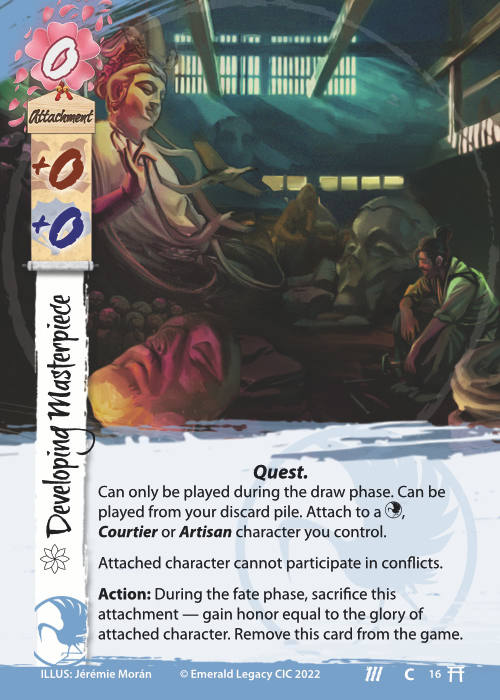
Crane honor strategies are unique in their approach. The Lion finds honor in a steady pace through abilities like Chronicler of Conquests, while forcing the game into a match with few card options as they force both players to bid low during the draw phase. The Phoenix does a similar strategy with low bids, and constant honor gain as their characters leave play honored by effects like Guardian Dōjō. Crane’s honor is different — it is explosive. At the heart of Crane’s honor is a playstyle that remains aggressive while pursuing an honor victory. Be it in Mioko’s Song taking one step back to take two steps forward, or in Seven Fold Palace bidding higher for cards and then turning those resources into explosive honor gains in victory. For the Lion, honor is found after decades in the dojo doing the same kata. For the Phoenix, it is found after decades in the library studying the same prayers. The Crane understand that honor is found in excellence — excellence reached after risk and sacrifice, when the artist touches something larger than life, in a moment of perfect beauty.
The Desperate Aide represents one of the courtiers of the Crane clan, tasked with the impossible duty of building a court and keeping propriety while being thrown deep into the unknown of the wilderness. It is not an easy task, but they are resourceful and will find a way. The character comes as a cheap piece to maneuver around early conflicts, while building up resources and looking for key cards needed to handle the match. Its composure ability is very powerful, and can more than make up for any cards missed due to having to bid lower than your opponent. As we envision a Crane honor strategy that is not tied to constantly bidding one, it can be costly for the opponent to stay on the lowest bid possible. When facing strategies reliant on Seven Fold Palace, the opponent must stay on their toes as the Crane player is sure to pack enough of a punch to get over an opponent who refuses to draw cards.
In Developing Masterpiece we reflect on the toil and risk that comes with chasing excellence. On the surface, Developing Masterpiece costs only zero fate for a good chunk of honor. In practice the cost of playing Masterpiece is unknown. This attachment can only be played during the Draw Phase, and at that moment the Crane player makes a commitment: the artist will not be able to participate in conflicts for the whole round while they work on their art. Later, after all the challenges of the Conflict Phase, if the artist is still alive and if the attachment is still in play, then they can reap the fruits of their labor, while if something goes wrong along the way they can try again next round. How many conflicts were lost in the absence of the artist? Did any of those conflicts cost honor via ring effects or unopposed honor loss? And what was the cost of keeping both the artist and their work in play? If the Crane is exposed to uncertainty about the cost of the art, their opponent faces the flip side of that uncertainty: the honor gain from the Masterpiece is not limited. If combined with other effects to increase the glory of the artist truly astounding gains of honor can be achieved. How high can we reach? Can we bear the cost of greatness?
We would also like to take a moment to thank all our volunteer illustrators and writers. Developing Masterpiece is a tribute to you. We would be nowhere without the awe-inspiring art you deliver. Thank you.
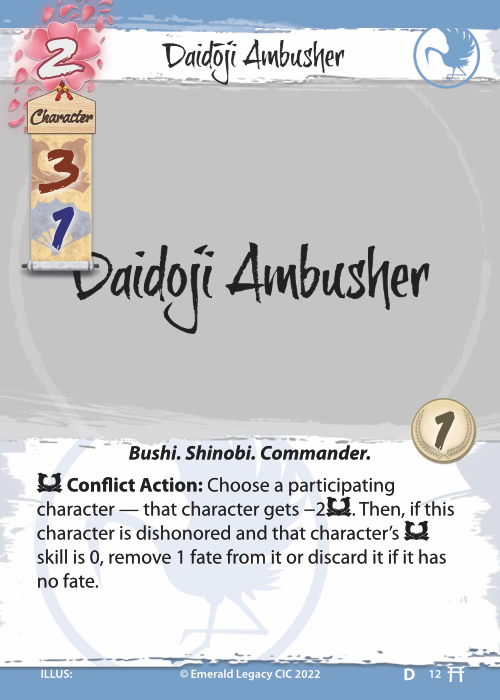
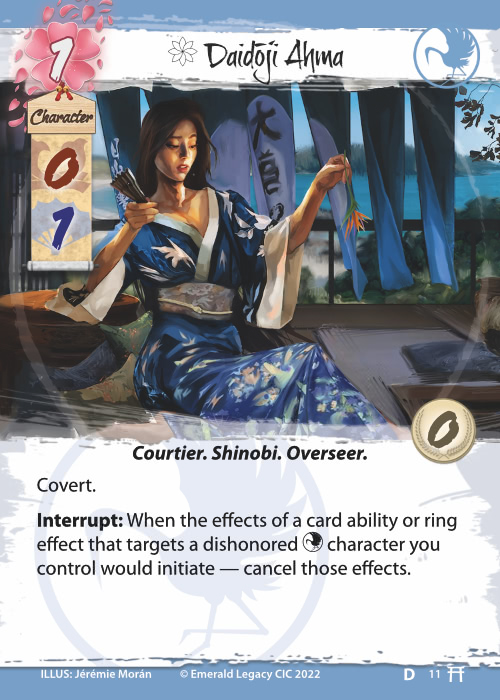
To protect the courtiers and artisans from the dangers of Sanctuary, the Crane brought along a few Daidōji. The Daidōji theme is expanded as a complement to Mioko’s Song. It is built around the shinobi and scouts of the Crane, with a quick play style focused on seizing and holding the rhythm of the game.
The Daidōji Ambusher leads the forces with a solid stat line and a dangerous ability. The basic effect of their ability empowers Crane to harass their opponents with skill penalties. While defending, this can be combined with movement and Storm from Sakkaku for efficient defenses. While attacking, it turns the Ambusher into a virtual 5 Military character. That versatile ability becomes more dangerous once the Ambusher accepts that their duty to the Crane might cost their honor, as the skill penalty can then turn into character destruction as they take down any weaker opposition. Even stronger adversaries can be taken down by combining multiple copies of Ambusher, dishonor tokens on the enemy, or some lessons from the Scorpion on how to Discourage Pursuit.
Daidōji Ahma comes to give support to the activities of the harriers. She is a tiny character who might not look like much, but she knows how to avoid enemies who are too strong to be handled and she also gives protection to herself and other Crane characters who find themselves in murky waters. The Daidōji strategy pushes the Crane board into running multiple dishonored characters, which makes them vulnerable to many common control tools. They also depend heavily on low-cost characters, leaving them exposed to effects like Assassination. With all those weak spots, the Daidōji are also in trouble by having harder access to Voice of Honor. Ahma’s role is to cover for those weaknesses, allowing this new strategy to develop as an alternative to the staples of Crane.
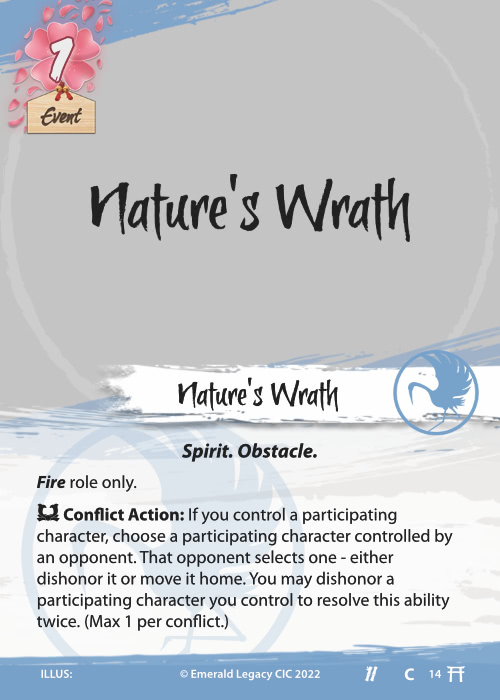
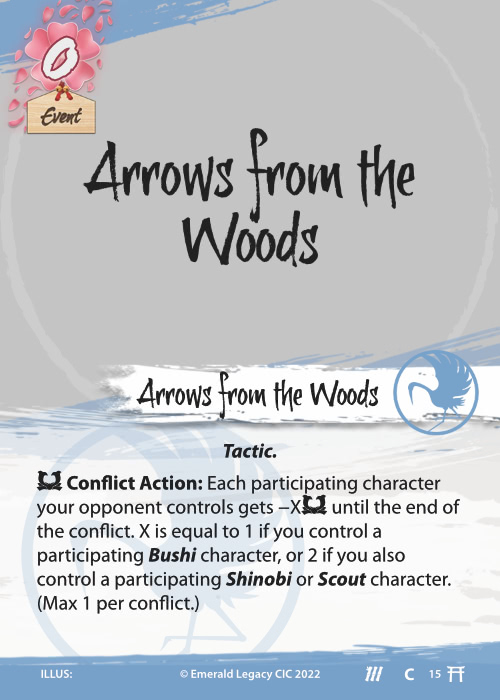
The spirits of the land are not interested in having the Crane around. Furthermore, as the seven clans establish their settlements and interests, conflict is expected to brew. The Crane strive for peace, but the Daidōji stay ready to protect their brethren. Even if unorthodox tactics are required.
The Crane face Nature’s Wrath in their new beginning. The spirits of the forest can possess wild creatures, imbuing them with mystical strength and then unleashing them on unsuspecting soldiers. The combined powers of supernatural and earthly strength can overwhelm the staunchest warriors. Some lose their grit and run home in despair. Others stay back frozen in place, as visible fear makes them lose face. The spirits do not distinguish between clans, and they will challenge guests or hosts in the Crane settlements.
To fight back against their adversaries the Crane can deploy Arrows from the Woods. The classic duelist style of Crane can usually rely on Kakita Kaezin as their tool against wide strategies, but when Crane moves away from dueling, wide strategies become hard to manage. By depending on their shinobi and scouts the Crane can use Arrows from the Woods to great effect. It provides a sizable advantage against armies of 2 characters or more, often being able to undo an opponent’s Banzai! without the need for honor to be spent. When used in larger conflicts, for example on the final charge against an opponent’s stronghold, Arrows from the Woods can deliver extremely high payoffs.
The Road to Redemption
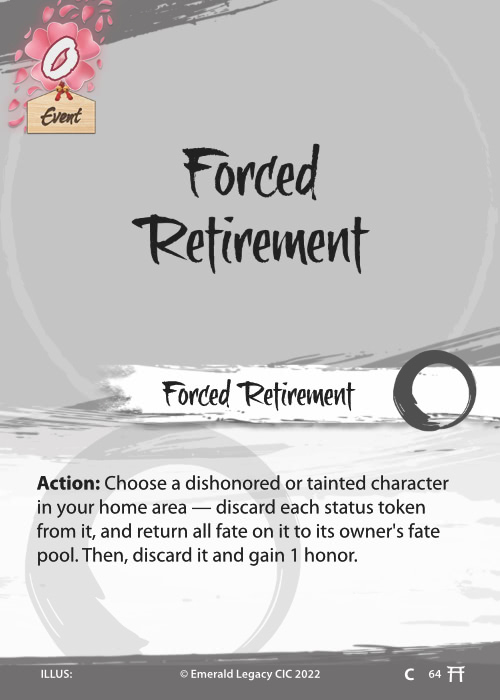
Many forms of character removal in the game rely on getting the target dishonored first. Often when a key character gets dishonored their days are numbered. Similarly it can happen that a Tainted character becomes too much of a liability to keep around. And last, of course, sometimes we ourselves dishonor our characters a bit too much and put ourselves in trouble.
Fortunately, even a dishonored samurai can find a way back into redemption. Let them join a monastery and go into contemplation over their sins.
Forced Retirement is a tool for decks exposed to dishonor strategies, it allows the player to recover part of the investment on that character, then recover some of the honor that would be lost.
And that’s it for this week’s preview. We hope you like the cards and look forward to more discussions on Discord, Reddit and Facebook!
By the way, Ancient Secrets will be legal at the Kotei in Nuremberg. 🙂

